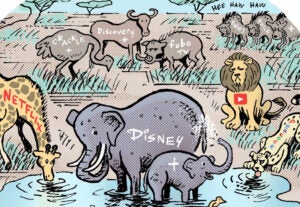 As he intimated back in 2011, Monetate isn’t just servicing the e-commerce industry with its website optimization technology and analytics, says CEO David Brussin. It’s addressing the individual consumer as well.
As he intimated back in 2011, Monetate isn’t just servicing the e-commerce industry with its website optimization technology and analytics, says CEO David Brussin. It’s addressing the individual consumer as well.
And yet, in spite of expanding into travel, financial services, and publishing, among other areas, Brussin thinks e-commerce giant Amazon is one of his company’s chief competitors. “Everybody’s focused on Amazon, but they don’t want to compete [with Amazon]. We do.” He claims that, at peak, a quarter of all U.S. online retail spend is running through Monetate’s platform and has resulted in a doubling of revenue year-over-year, though he declines to provide exact figures.
Brussin doesn’t pull any punches when discussing where he and his 170-person company can potentially compete: “As good as Amazon is at testing and making decisions on data – and at least having a willingness to invest in getting the right experience in front of a given customer – it’s ultimately not just about the SKU that a customer can find in one place or another.”
Brussin spoke to AdExchanger recently about his company’s momentum and industry trends.
Adexchanger: Do you think of Monetate as being in the marketing automation space?
DAVID BRUSSIN: One could certainly think of us as being in that universe. What Monetate is fundamentally about is helping marketers know their customer and take action. It’s the combination of those two that’s very unique to our business. That kind of defies trying to put it in an analytics space, which could be more on the customer side or a marketing automation space, which would be more on the “take action” side.
When I think about all of the organizations we’ve talked with and hear their pain points, it’s the same thing everywhere. There are three silos that are very disconnected. The first one is data-focused – this silo has a tough job. There’s more data today than there’s ever been before and the team responsible for data is struggling to just write it all down. It’s like that “I Love Lucy” scene where the candy is coming down the conveyor belt. It’s a race for them to try to record everything and figure out how, in the future, they’re going to make it accessible.
The second silo is around analysis. It’s usually tragically under resourced. You’ve got a couple people who are trying to make sense of some of what’s being recorded. For the most part they don’t have access to any of the new data because those connections haven’t been made yet. They tend to be directed largely by what they historically report on because they’re expected to keep doing that and answer whatever questions might arise from the CEO or company board member. They make stuff available a long time after the questions are asked, too, – in many cases due to resource issues – and then they move on. It’s not connected to anything else in the organization – certainly not the third silo, which is all around “action.”
The third silo is where the business actually moves. With the cadence of action that marches on everyday, whether it’s influenced by what’s being learned or not, ads get bought and run, stores get stocked, websites get created and populated with data, and so on. I’ve never heard of a company saying we’re not going to send our e-mail, buy search ads and run our display ads today because we haven’t learned how we did yesterday. So that action silo’s very disconnected from the other two.
Our job is to fit between these three silos and cross the bridge between business intelligence, analytics, and marketing automation in order to allow marketers to do it all in the same workflow, to understand their customer a little bit better everyday, and act on that understanding a little better everyday.
Where does the paid channel and programmatic media come into it for Monetate?
“Programmatic” represents these silos becoming increasingly connected in paid media channels. The more expensive and competitive the channel, the sooner the connections have happened. You start to see programmatic structures and behavior in paid search quickly as people work to try to be efficient with how they bid and make sure that they are making smart decisions. We’ve seen a revolution over the last few years in display around this.
There’s a competitive advantage for someone who can take the targeting data that’s available, understand what it means in the context of their business, and then act in terms of how they’re bidding in the exchanges on that data. There’s still not quite enough focus in any of the channels on the creative side, which is one of the reasons I’m excited about the way I hear [Google’s] Neal Mohan talking about the display business. In a lot of ways what Monetate does is programmatic creative. There actually is some bidding and exchange dynamics within our world – it just happens within an “owned” media rather than “paid” media channel. It’s about making decisions about what you do with an opportunity, but if you already own the opportunity you’re not deciding how much to pay for it, you’re trying to decide, of the various things you could do with that opportunity, which is the most valuable. It’s almost like running your own internal exchange for your own impressions and then making good decisions internally about how to use the impressions that you already have.
So, would you say Monetate is a dynamic creative optimization solution for the landing page?
You’re touching the edge of it. It’s about the creative experience. It’s not just a landing page, it’s every single part of the experience and it’s about making that dynamic – making the rich data, and the insights from the data accessible to the marketer so that they can make real-time decisions anywhere in the experience. Not just visual creative, but things like functionality can all change anywhere in an experience.
Is Monetate buying media today?
We’re not.
Doesn’t it make sense at some point, though, that those two get merged, what you’re offering and media buying? Why don’t you add the media buying?
It’s been a focus thing for us. Just as Salesforce.com sees that the ExactTarget is important for their business based on the way the CMO is thinking about business, we’re seeing the same thing – obviously not on Salesforce.com’s scale, but on our scale we see that the CMO cares about their customer experiences across all channels.
We’ve already made announcements to our customers about things that we’re doing in other channels off the website. We’re very active today in web experiences on the desktop, tablet, mobile, and are starting to add other channels. We’ve committed to making the things that Monetate does today available to marketers in e-mail, display and mobile applications.
You talk a lot about serving the marketer and yet on your website there’s an offering for agencies. If you were to build an agency that hooks into Monetate, what would that look like?
I’d build an agency that was very focused on building long-term sustainable value for their clients. That sounds very fluffy, but I mean something that’s very concrete.
Agencies are typically transactionally focused on short-term metrics. If I was going to build an agency I’d want to work with customers who wanted to measure my effectiveness based on very long-term pictures, lifetime customer value contribution, annual customer value at the shortest scope – not what’s the immediate impact on the business of this one impression or campaign in a given channel.
This comes back to some of the things I was saying earlier about Amazon. If I was running an agency, I’d try to create some of the positive cultural things that I see in Amazon that would lead to great competitiveness in my customers. I’d also be trying to nurture and create some of the cultural things that make for tremendous effectiveness in competing against Amazon.
I’d be looking to combine a data focus: having the voice of the customer come through data and making decisions focused on testing and learning; a recognition that customers are different and that one size does not fit all; and, combining all that with curation and a strong brand perspective.
Follow David Brussin (@dbrussin), Montetate (@monetate) and AdExchanger.com (@adexchanger) on Twitter.













